Punjab State Board PSEB 8th Class Maths Book Solutions Chapter 11 Mensuration Ex 11.3 Textbook Exercise Questions and Answers.
PSEB Solutions for Class 8 Maths Chapter 11 Mensuration Ex 11.3
1. There are two cuboidal boxes as shown in the figures. Which box requires the lesser amount of material to make?
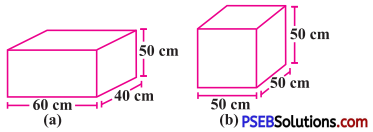
Solution:
For 1st cuboidal box:
length (l) = 60 cm, breadth (b) = 40 cm and height (h) = 50 cm
Total surface area of a cuboid
= 2 (lb + bh + lh)
= 2 [(60 × 40) + (40 × 50) + (50 × 60)]
= 2 (2400 + 2000 + 3000)
= 2(7400)
= 14,800 cm2
For 2nd cuboidal box:
l = b = h = 50 cm
Total surface area of a cuboid
= 2 (lb + bh + lh)
= 2 [(50 × 50) + (50 × 50) + (50 × 50)]
= 2(2500 + 2500 + 2500)
= 2 × 7500
= 15,000 cm2
As, total surface area of cuboid (a) is less, so the box (a) requires the less amount of material to make.
![]()
2. A suitcase with measures 80 cm × 48 cm × 24 cm is to be covered with a tarpaulin cloth. How many metres of tarpaulin of width 96 cm is required to cover 100 such suitcases?
Solution:
Let us find total surface area of a suitcase (cuboidal in shape).
length (l) = 80 cm, breadth (b) = 48 cm and height (h) = 24 cm
∴ Total surface area of a suitcase = 2 (lb + bh + lh)
= 2 [(80 × 48) + (48 × 24) + (24 × 80)]
= 2(3840 + 1152 + 1920)
= 2 (6912)
= 13,824 cm2
Total surface area of such 100 suitcases = 13,824 × 100
= 13,82,400 cm2
Area of 1 metre trapezium
= length × breadth
= 100 × 96 = 9600 cm2
Tarpaulin required to cover 100 suitcases = \(\frac{1382400}{9600}\) = 144 metres
Hence, 144 m tarpaulin is required to cover 100 suitcases.
3. Find the side of a cube whose surface area is 600 cm2.
Solution:
Let the side of the cube be x cm
Total surface area of a cube = 6x2
Total surface area of the cube = 600 cm2 (Given)
∴ 6x2 = 600
∴ x2 = \(\frac {600}{6}\)
∴ x2 = 100
∴ x2 = 102
∴ x = 10
Hence, the side of the cube is 10 cm.
4. Rukhsar painted the outside of the cabinet of measure 1 m × 2 m × 1.5 m. How much surface area did she cover if she painted all except the bottom of the cabinet.
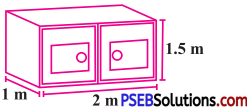
Solution:
For given cabinet:
length (l) = 2 m, breadth (b) = 1 m and height (h) = 1.5 m
Total surface area of the cabinet
= 2 (lb + bh + lh)
= 2 [(2 × 1) + (1 × 1.5) + (2 × 1.5)]
= 2 (2 + 1.5 + 3)
= 2(6.5) = 13 m2
She has not painted bottom. So subtract area of bottom from total surface area of the cabinet.
Area of bottom = l × b = 2 × 1 = 2m2
∴ Painted surface area = (13 – 2) m2 = 11 m2
Hence, she has painted 11 m2 area of a cabinet.
![]()
5. Daniel is painting the walls and ceiling of a cuboidal hall with length, breadth and height of 15 m, 10 m and 7 m respectively. From each can of paint 100 m2 of area is painted. How many cans of paint will she need to paint the room?
Solution:
For given wall:
length (l) = 15 m, breadth (b) = 10 m and height (h) = 7 m
∴ Area to be painted
= Area of 4 walls + Area of ceiling
= [2 (l + b) × h] + l × b
= [2(15 + 10) × 7] + 15 × 10
= [2(25) × 7] + 150
= 350 + 150 = 500 m2
Now, one can of paint covers 100 m2 area.
∴ Number of paint cans needed
= \(\frac{\text { Area to be painted }}{\text { Area painted by one can }}=\frac{500 \mathrm{~m}^{2}}{100 \mathrm{~m}^{2}}\)
Hence, 5 cans of paint will be needed.
6. Describe how the two figures given are alike and how they are different. Which box has larger lateral surface area?
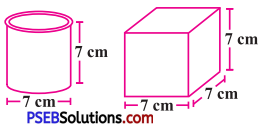
Solution:
Here, figure (i) is cylinder and figure (ii) is cube.
Similarity: Both have the same height.
Difference: One is the cylinder and the other is a cube.
For cylinder:
Radius = \(\frac{\text { diameter }}{2}=\frac{7}{2}\) = cm
Height = 7 cm
∴ Lateral (curved) surface area of cylinder
= 2πrh
= 2 × \(\frac{22}{7} \times \frac{7}{2}\) × 7
= 22 × 7 = 154 cm2
For given cube:
side = 7 cm
Lateral surface area of the cube
= 4l2 = 4 × 72
= 4 × 49 = 196 cm2
Hence, cubical box has a larger area.
![]()
7. A closed cylindrical tank of radius 7 m and height 3 m is made from a sheet of metal. How much sheet of metal is required?
Solution:
For given cylindrical tank:
radius (r) = 7 m, height (h) = 3 m
Total surface area of tank
= 2πr (r + h)
= 2 × \(\frac {22}{7}\) × 7(7 + 3)
= 44(10) = 440 m2
Hence, 440 m2 sheet of metal is required.
8. The lateral surface area of a hollow cylinder is 4224 cm2. It is cut along its height and formed a rectangular sheet of width 33 cm. Find the perimeter of rectangular sheet?
Solution:
Lateral surface area of a hollow cylinder = 4224 cm2 (Given)
Let length of a rectangular sheet made from hollow cylinder be l cm.
∴ l × b = 4224
∴ 1 × 33 = 4224
∴ l = \(\frac {4224}{33}\) = 128 cm
∴ Length of rectangular sheet =128 cm
Perimeter of rectangular sheet
= 2 (l + b)
= 2 (128 + 33)
= 2 (161) = 322 cm
Hence, perimeter of rectangular sheet is 322 cm.
9. A road roller takes 750 complete revolutions to move once over to level a road. Find the area of the road levelled if the diameter of a road roller is 84 cm and length is 1 m.
Solution:
Shape of road roller is cylindrical.
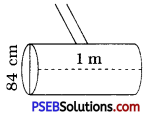
For given cylinder:
Radius (r) = \(\frac{\text { diameter }}{2}\) = \(\frac {84}{2}\) = 42cm
length (height) (h) = 1 m = 100 cm
∴ Curved surface area of a roller
= 2 πrh
= 2 × \(\frac {22}{7}\) × 42 × 100
= 26,400 cm2
Roller covers area of 26,400 cm2 in 1 revolution.
∴ Area of covered by roller in 750 revolutions
= 26400 × 750 cm2
= \(\frac{26400 \times 750}{100 \times 100}\) m2
= 1980 m2
Hence, area of road levelled is 1980 m2.
![]()
10. A company packages its milk powder in cylindrical container whose base has a diameter of 14 cm and height 20 cm.
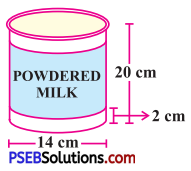
Company places a lable around the surface of the container (as shown in the figure). If the lable is placed 2 cm from top and bottom, what is the area of the label.
Solution:
For given cylindrical container:
radius (r) = \(\frac {diameter}{2}\) = \(\frac {14}{2}\) = 7 cm
height (h) = 20 cm
Now, label is placed 2 cm away from top and bottom.
∴ Height of label = (20 – 2 – 2) cm
= (20 – 4) cm = 16 cm
For label:
radius (r) = 7 cm, height (h) = 16 cm
∴ Area of cylindrical label = 2πrh
= 2 × \(\frac {22}{7}\) × 7 × 16
= 44 × 16
= 704 cm2
Hence, area of the label is 704 cm2.